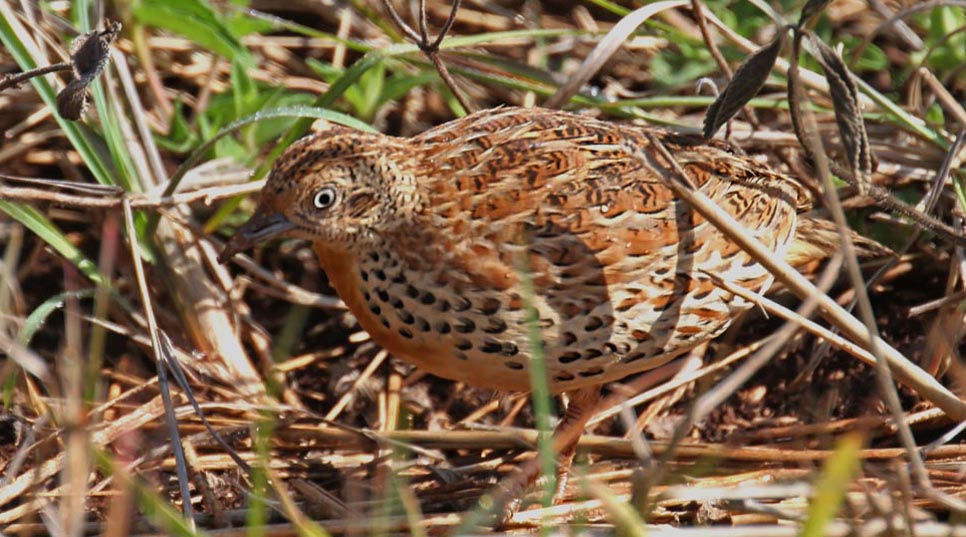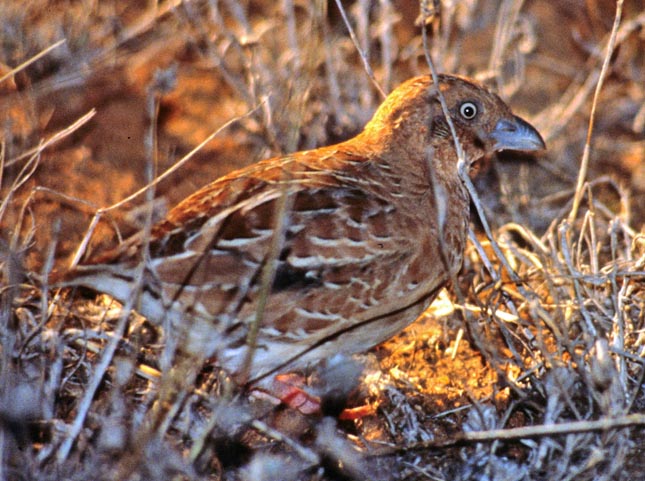
a web page by Don Roberson |
BUTTONQUAILS Turnicidae |
|
The most widespread species — present in pan-African and south Asia tropics — is Small Buttonquail (below, in a close photo by Adam Riley). Its range includes population in s. Spain to the Philippines and Bali. |
 |
The origins of Buttonquail have long been uncertain. Early taxonomists placed them near tinamous, or mesites, and galliformes. By the time of Vol. 3 of Handbook of the Birds of the World (Debus 1996) they were placed among rails and cranes in the Gruiformes, "by recent consensus." Molecular analysis proved this to be wrong — buttonquails are in the Charadriiformes, and in the clade that leads to pratincoles, alcids, gulls and terns. Buttonquails diverged from the remainder of this clade about 36 mya (Prum et al. 2015) or about 43 mya (Claramunt & Cracraft 2015). Both of those studies attempted to create time-trees matched to the fossil record, and it surprises me that there is still this extent of disagreement over the dates of divergence. Modern buttonquails are assigned to just two genera: 15 species in Turnix and just one species in Ortyxelos. The latter is Quail-plover (sometimes called "Lark Buttonquail," e.g. Debus 1996) Ortyxelos meiffrenii of arid grasslands in the Sahel along the southern edge of the Saharan desert and locally in dry parts of east Africa. Female Turnix buttonquails have an inflatable bulb in the oesophagus which is used as a specialized vocal organ for "booming." Female Turnix buttonquails defend territories and engage in "booming" to attract males. The Quail-plover is quite different. Females do not have the vocal organ and do not "boom," and they may breed solitarily as monogamous pairs. Quail-plover is by far the tiniest of the buttonquails, and may be nomadic. Among Turnix buttonquails, Hottentot T. hottentotta is endemic to Africa while Madagascar Buttonquail T. nigricollis is endemic to that island. Two species — Yellow-legged T. tanki and Barred T. suscitator — have wide ranges in south Asia; the latter is further distributed east to the Philippines, Sulawesi, and Lesser Sundas. Red-backed T. maculosa occurs from eastern Indonesia to New Guinea and northern Australia. Sumba Buttonquail T. everetti is endemic to Sumba and Luzon Buttonquail T. worcesteri is a almost-unknown mystery species in n. Luzon. Spotted Buttonquail T. ocellata is also a Luzon endemic but can be viewed locally. The remaining six species (including Little Buttonquail shown at top of this page) are Australian endemics. |
Photos: Ed Harper photographed the Little Buttonquail Turnix velox near Deniliquin, New South Wales, Australia, in Dec 1999. Adam Riley photographed the Small Buttonquail Turnix sylvatica in Akagera NP, Rwanda. Bibliographic note: There is no "family book" for this small family but a nice introduction to the family's attributes (but not current as its evolution) is in the Handbook of the Birds of the World series (Debus 1996). Literature cited:
|
 The
Buttonquails are among the most elusive birds in the world, and it is
remarkable to me that anyone gets a photo! My views have been fleeting
looks at little birds crossing a track or a burst of feathers in fast
flight when accidentally flushed in grasslands. Now known to be related
to shorebirds, these small ground-loving species have long been a
mystery. They behave a bit like a quail but are not remotely related.
They hide in thick grass and scrub, and are often crepuscular, most
active at dawn or dusk. Ed Harper got this photo of Little Buttonquail (left) at dusk near Deniliquin, New South Wales, Australia.
The
Buttonquails are among the most elusive birds in the world, and it is
remarkable to me that anyone gets a photo! My views have been fleeting
looks at little birds crossing a track or a burst of feathers in fast
flight when accidentally flushed in grasslands. Now known to be related
to shorebirds, these small ground-loving species have long been a
mystery. They behave a bit like a quail but are not remotely related.
They hide in thick grass and scrub, and are often crepuscular, most
active at dawn or dusk. Ed Harper got this photo of Little Buttonquail (left) at dusk near Deniliquin, New South Wales, Australia.